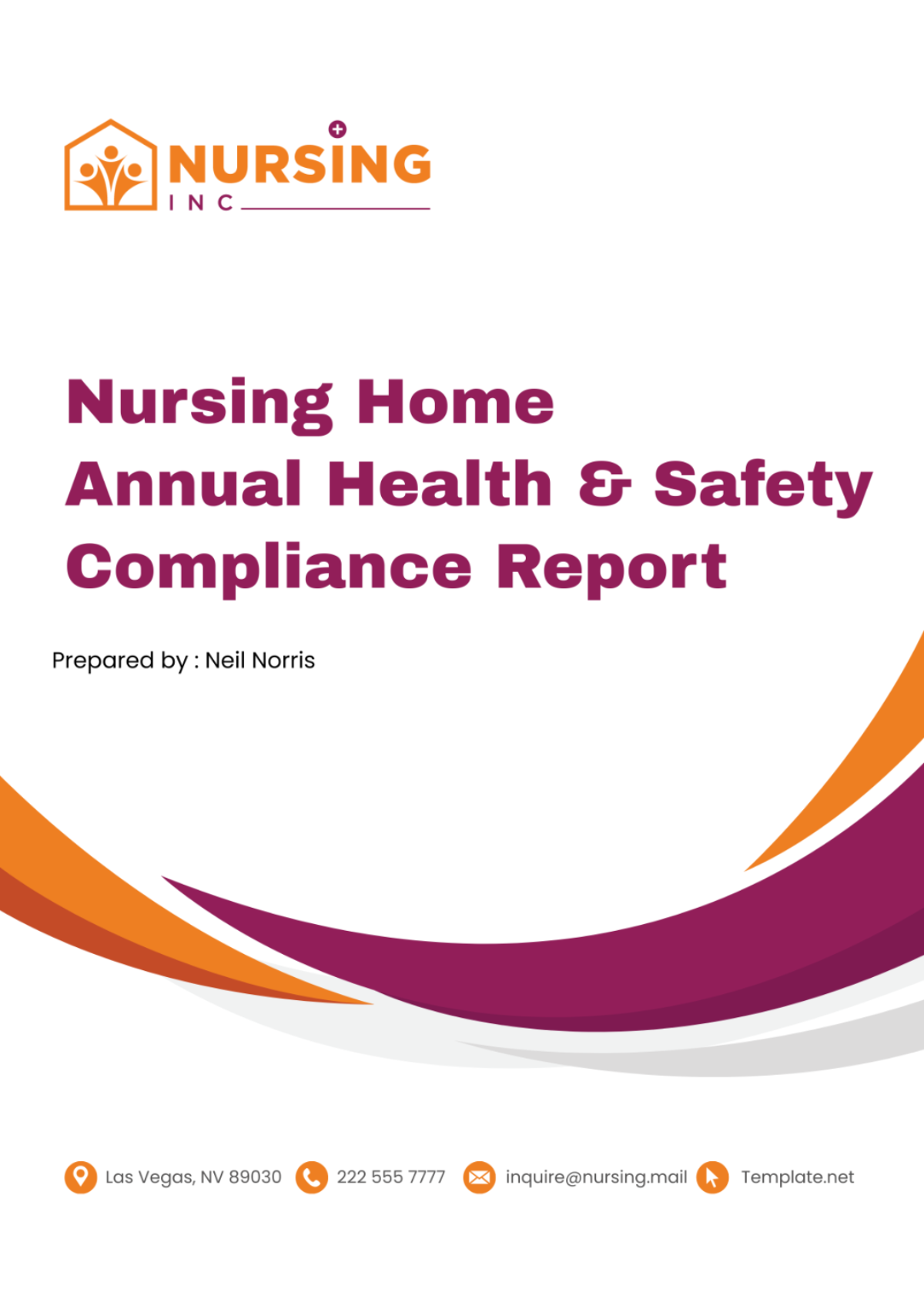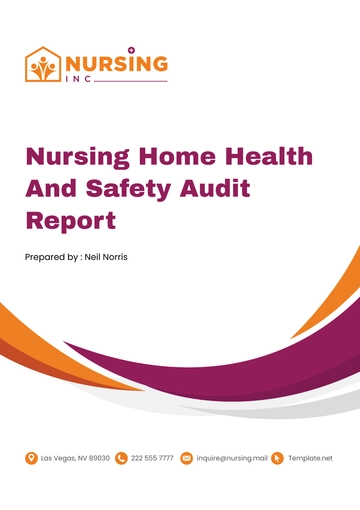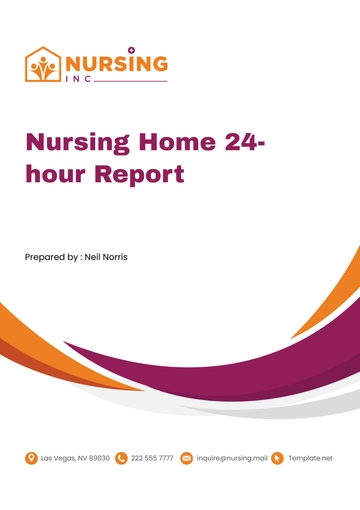Free Nursing Home Annual Health & Safety Compliance Report

I. Introduction
A. Overview
Purpose of the Report
The Annual Health & Safety Compliance Report serves as a vital document that not only reflects our commitment to transparency but also underscores our dedication to ensuring the highest standards of care and safety within [Your Company Name] Nursing Home. By meticulously evaluating our compliance with health and safety regulations, this report enables us to identify areas of strength and areas for improvement, ultimately enhancing the quality of life for our residents and fostering a safe working environment for our staff.
Scope
This report delves into various aspects of health and safety compliance, encompassing a wide array of protocols and procedures designed to mitigate risks and promote well-being. It covers key areas such as facility maintenance, infection control measures, emergency preparedness protocols, staff training, and certification requirements. By providing a comprehensive overview of our compliance efforts, this report facilitates informed decision-making and drives continuous improvement initiatives.
Audience
The primary audience for this report includes internal stakeholders such as management, administrative staff, and frontline healthcare professionals who play pivotal roles in upholding our commitment to excellence. Additionally, regulatory bodies, accrediting agencies, residents, families, and other relevant parties involved in the oversight of nursing home operations may find value in the insights and recommendations presented herein. By disseminating this information to a broad spectrum of stakeholders, we aim to foster transparency, accountability, and trust in our operations.
II. Executive Summary
A. Key Findings
In the past year, [Your Company Name] Nursing Home has demonstrated commendable efforts in maintaining compliance with health and safety regulations. Key findings from the assessment period include:
Key Metric | Compliance Rate |
|---|---|
Overall Compliance Rate | [99]% |
Hand Hygiene Compliance | [89]% |
Emergency Preparedness Drills | [80]% |
Staff Training Completion Rate | [75]% |
B. Summary of Action Plan
To address identified areas for improvement and build upon our successes, the following action plan has been developed:
Immediate Corrective Actions:
Implementing additional infection control measures, such as enhanced cleaning protocols and the utilization of advanced disinfection technologies.
Conducting staff retraining sessions on emergency response protocols, including evacuation procedures and crisis management strategies.
Enhancing facility maintenance procedures, with a focus on timely repairs and proactive maintenance to ensure the integrity of the physical environment.
Long-Term Strategies for Improvement:
Investing in advanced infection control technologies, such as UV-C disinfection systems and antimicrobial surfaces, to bolster our defenses against infectious diseases.
Reviewing and updating emergency response plans based on lessons learned from simulated drills and real-world incidents, with a focus on optimizing response times and ensuring the safety of residents and staff.
III. Facility Overview
A. Facility Information
Name: [Your Company Name] Nursing Home
Address: [Your Company Address]
Contact Information: [Your Company Number] / [Your Company Email]
Number of Residents: [65]
Staff Category | Number Employed |
|---|---|
Registered Nurses (RNs) | [52] |
Licensed Practical Nurses (LPNs) | [30] |
Certified Nursing Assistants (CNAs) | [45] |
B. Description of Facility
Building Structure: [Your Company Name] Nursing Home is housed in a modern and spacious building designed specifically to cater to the needs of elderly residents. The facility boasts a contemporary architectural design, with 5 floors dedicated to various amenities and services aimed at promoting resident comfort and well-being.
The building features:
100 Resident Rooms: [Your Company Name] Nursing Home offers 100 well-appointed resident rooms, providing a peaceful and private space for individuals to call home. Each room is furnished with comfortable bedding, storage facilities, and personal touches to create a homely atmosphere.
Common Areas: Residents have access to spacious common areas where they can socialize, engage in recreational activities, and participate in community events. These areas include lounges, activity rooms, and communal dining spaces, fostering a sense of belonging and camaraderie among residents.
Dining Facilities: The facility boasts dining facilities equipped to cater to the nutritional needs and dietary preferences of residents. Meals are prepared by skilled culinary staff and served in inviting dining rooms, offering a pleasant dining experience reminiscent of home-cooked meals.
5 Rehabilitation Rooms: [Your Company Name] Nursing Home is equipped with state-of-the-art rehabilitation rooms designed to support residents in their journey towards recovery and rehabilitation. These rooms are outfitted with specialized equipment and amenities to facilitate physical therapy and occupational therapy sessions.
Administrative Offices: The facility houses administrative offices where staff members oversee daily operations, manage resident care plans, and coordinate services. These offices serve as the nerve center of [Your Company Name] Nursing Home, ensuring efficient communication and coordination among various departments.
Specialized Units (if applicable)
[Your Company Name] Nursing Home may include specialized units to cater to the unique needs of certain resident populations, such as:
Memory care units for residents with Alzheimer's disease or other forms of dementia.
Rehabilitation units for individuals recovering from surgery, injury, or illness.
Palliative care units for residents requiring end-of-life care and support.
Capacity and Occupancy Rates
The facility has a total capacity of [capacity] beds and maintains an average occupancy rate of [occupancy rate]% throughout the reporting period. This occupancy rate reflects the demand for long-term care services within the community and underscores the facility's role as a trusted provider of quality eldercare services.
IV. Health and Safety Compliance Metrics
A. Facility Maintenance
Regular Inspections and Maintenance Logs
[Your Company Name] Nursing Home conducts regular inspections of its physical infrastructure, including building systems, equipment, and grounds. Maintenance logs are meticulously maintained to track repair and maintenance activities, ensuring the timely resolution of issues and the preservation of a safe and functional environment for residents and staff.
Equipment Safety Checks
All medical equipment and assistive devices used within the facility undergo routine safety checks and maintenance to ensure optimal performance and mitigate the risk of malfunctions or accidents. Equipment safety protocols adhere to industry standards and regulatory requirements, with comprehensive documentation of inspection results and maintenance activities.
Environmental Safety Measures
The facility is equipped with various environmental safety measures to protect against hazards such as fires, floods, and other emergencies. This includes the installation and maintenance of fire detection and suppression systems, emergency lighting, evacuation routes, and signage. Regular drills and training sessions are conducted to ensure staff readiness in responding to emergencies effectively.
B. Infection Control
Hand Hygiene Compliance Rates
Hand hygiene is a critical component of infection control efforts at [Your Company Name] Nursing Home. Compliance rates are monitored through regular audits and observations, with staff encouraged to adhere to hand hygiene protocols before and after resident interactions, as well as following contact with potentially infectious materials or surfaces.
Surveillance for Healthcare-Associated Infections
The facility maintains robust surveillance systems to monitor and track healthcare-associated infections (HAIs) among residents and staff. This includes the timely identification, reporting, and investigation of suspected cases, as well as the implementation of infection prevention and control measures to contain outbreaks and prevent transmission within the facility.
Personal Protective Equipment (PPE) Usage
Staff members are provided with appropriate personal protective equipment (PPE), including gloves, masks, gowns, and eye protection, as necessary to prevent exposure to infectious agents and other hazards. Training on proper PPE usage and disposal is provided regularly to ensure staff competency and minimize the risk of cross-contamination.
C. Emergency Preparedness
Emergency Response Plans
[Your Company Name] Nursing Home maintains comprehensive emergency response plans tailored to various scenarios, including fires, natural disasters, infectious disease outbreaks, and other emergencies. These plans outline clear roles and responsibilities for staff members, evacuation procedures, communication protocols, and measures for ensuring resident safety and well-being.
Staff Training and Drills
Staff members undergo regular training and drills to familiarize themselves with emergency response protocols and procedures. This includes simulated exercises to practice evacuation procedures, triage protocols, and coordination with external emergency services. Training sessions are conducted periodically to reinforce skills and knowledge and ensure staff readiness in the event of an emergency.
Communication Systems
Effective communication is essential during emergencies to facilitate timely response and coordination among staff members, residents, families, and external stakeholders. [Your Company Name] Nursing Home utilizes various communication systems, including intercoms, mobile devices, and emergency notification systems, to disseminate critical information and instructions during emergencies and ensure swift and coordinated action.
D. Staff Training and Certification
Compliance with Mandatory Training Requirements
All staff members undergo mandatory training on relevant health and safety topics, including infection control, emergency preparedness, resident rights, and abuse prevention. Training programs are tailored to the specific roles and responsibilities of staff members and are designed to enhance knowledge, skills, and competencies in providing safe and compassionate care to residents.
Staffing Ratios and Workforce Competency
[Your Company Name] Nursing Home maintains appropriate staffing ratios to meet the care needs of residents and ensure their safety and well-being. Staff members are selected based on their qualifications, experience, and commitment to upholding the highest standards of care. Ongoing professional development opportunities are provided to staff members to enhance their skills and competencies and support career advancement within the organization.
V. Areas of Improvement
A. Identified Non-Compliance Issues
Summary of Findings
During the reporting period, [Your Company Name] Nursing Home identified several areas of non-compliance with health and safety regulations. The following summarizes key findings:
Area of Non-Compliance | Summary of Issue |
|---|---|
Infection Control Measures | Insufficient adherence to hand hygiene protocols among staff, resulting in increased risk of healthcare-associated infections. |
Facility Maintenance | Deferred maintenance issues, including malfunctioning equipment and environmental hazards, posing safety risks to residents and staff. |
Emergency Preparedness | Inadequate staff training and preparedness for emergencies, leading to delays in response and potential lapses in resident safety. |
Root Causes Analysis
The identified non-compliance issues stem from various underlying factors, including:
Staffing shortages and high turnover rates impacting training and adherence to protocols.
Limited resources and budget constraints affecting maintenance and facility upgrades.
Communication breakdowns and coordination challenges during emergencies.
B. Corrective Actions Taken
Immediate Remedial Measures
To address the identified non-compliance issues, [Your Company Name] Nursing Home has implemented the following immediate corrective actions:
Corrective Action | Implementation Details |
|---|---|
Intensified Hand Hygiene Education and Monitoring | Conducting additional staff training sessions on proper hand hygiene techniques and increasing monitoring and feedback mechanisms. |
Expedited Maintenance and Repairs | Prioritizing and expediting maintenance and repair tasks to address identified safety hazards and equipment malfunctions promptly. |
Enhanced Emergency Response Training | Conducting emergency response drills and training sessions to improve staff readiness and coordination during crisis situations. |
Preventive Strategies
In addition to immediate corrective actions, [Your Company Name] Nursing Home is implementing preventive strategies to mitigate future non-compliance issues:
Developing comprehensive infection control protocols and providing ongoing education and reinforcement to staff members.
Implementing a proactive maintenance schedule and investing in infrastructure upgrades to prevent deferred maintenance issues.
Enhancing emergency preparedness training and communication systems to ensure timely and effective responses to emergencies.
VI. Action Plan for Addressing Deficiencies
A. Prioritized Recommendations
Based on the findings and root causes analysis, [Your Company Name] Nursing Home has developed the following prioritized recommendations for addressing deficiencies:
Short-Term Goals
Priority Area | Recommendations |
|---|---|
Infection Control Measures | Implementing regular audits and feedback mechanisms to monitor hand hygiene compliance and address gaps in infection control practices. |
Facility Maintenance | Establishing a maintenance task force to oversee the implementation of corrective actions and preventive maintenance strategies. |
Emergency Preparedness | Conducting tabletop exercises and scenario-based training sessions to simulate emergency situations and improve staff preparedness. |
Long-Term Objectives
Priority Area | Recommendations |
|---|---|
Infection Control Measures | Investing in automated hand hygiene monitoring systems and advanced disinfection technologies to augment infection control efforts. |
Facility Maintenance | Developing a long-term maintenance plan and budget to address infrastructure needs and ensure ongoing facility upkeep and safety. |
Emergency Preparedness | Enhancing communication systems and protocols, including the integration of mobile technology for real-time updates and alerts during emergencies. |
B. Implementation Timeline
Responsible Parties
The implementation of the action plan will involve collaboration among various departments and stakeholders within [Your Company Name] Nursing Home, including:
Nursing and Clinical Staff
Maintenance and Facilities Management
Administration and Leadership Team
Quality Assurance and Compliance Officers
Monitoring and Evaluation
Progress towards achieving the action plan objectives will be monitored regularly through:
Routine inspections and audits
Compliance tracking and reporting
Staff feedback and input
Incident and near-miss reporting
VII. Conclusion
A. Summary of Achievements
Throughout the reporting period, [Your Company Name] Nursing Home has made significant strides in maintaining compliance with health and safety regulations while striving to provide the highest quality of care to our residents. Key achievements include:
Achieving an overall compliance rate of [Compliance Rate]% across key metrics.
Implementing immediate corrective actions to address identified non-compliance issues promptly.
Enhancing staff training and preparedness for emergencies through targeted education and training initiatives.
Investing in facility maintenance and infrastructure upgrades to ensure a safe and conducive environment for residents and staff.
Developing comprehensive action plans and preventive strategies to mitigate future risks and foster continuous improvement.
B. Commitment to Continuous Improvement
As we look ahead, [Your Company Name] Nursing Home remains steadfast in our commitment to continuous improvement and excellence in healthcare delivery. We recognize that maintaining compliance with health and safety regulations is an ongoing endeavor that requires vigilance, collaboration, and adaptability. We are dedicated to:
Monitoring and evaluating our performance regularly to identify areas for further improvement.
Engaging stakeholders at all levels to foster a culture of safety, accountability, and continuous learning.
Embracing innovation and best practices to enhance the quality of care and services provided to our residents.
Upholding our core values of compassion, integrity, and dignity in all aspects of our operations.
C. Closing Remarks
We extend our sincere gratitude to the dedicated staff, residents, families, and stakeholders who contribute to the success of [Your Company Name] Nursing Home. Together, we remain committed to our shared goal of promoting health, safety, and well-being for all those entrusted to our care.
- 100% Customizable, free editor
- Access 1 Million+ Templates, photo’s & graphics
- Download or share as a template
- Click and replace photos, graphics, text, backgrounds
- Resize, crop, AI write & more
- Access advanced editor
Ensure regulatory compliance with the Nursing Home Annual Health & Safety Compliance Report Template from Template.net. Editable and customizable, it simplifies the process of compiling and documenting health and safety data for annual reporting. Tailor it effortlessly using our Ai Editor Tool for personalized reports. Maintain compliance and ensure resident well-being with this essential template.
You may also like
- Sales Report
- Daily Report
- Project Report
- Business Report
- Weekly Report
- Incident Report
- Annual Report
- Report Layout
- Report Design
- Progress Report
- Marketing Report
- Company Report
- Monthly Report
- Audit Report
- Status Report
- School Report
- Reports Hr
- Management Report
- Project Status Report
- Handover Report
- Health And Safety Report
- Restaurant Report
- Construction Report
- Research Report
- Evaluation Report
- Investigation Report
- Employee Report
- Advertising Report
- Weekly Status Report
- Project Management Report
- Finance Report
- Service Report
- Technical Report
- Meeting Report
- Quarterly Report
- Inspection Report
- Medical Report
- Test Report
- Summary Report
- Inventory Report
- Valuation Report
- Operations Report
- Payroll Report
- Training Report
- Job Report
- Case Report
- Performance Report
- Board Report
- Internal Audit Report
- Student Report
- Monthly Management Report
- Small Business Report
- Accident Report
- Call Center Report
- Activity Report
- IT and Software Report
- Internship Report
- Visit Report
- Product Report
- Book Report
- Property Report
- Recruitment Report
- University Report
- Event Report
- SEO Report
- Conference Report
- Narrative Report
- Nursing Home Report
- Preschool Report
- Call Report
- Customer Report
- Employee Incident Report
- Accomplishment Report
- Social Media Report
- Work From Home Report
- Security Report
- Damage Report
- Quality Report
- Internal Report
- Nurse Report
- Real Estate Report
- Hotel Report
- Equipment Report
- Credit Report
- Field Report
- Non Profit Report
- Maintenance Report
- News Report
- Survey Report
- Executive Report
- Law Firm Report
- Advertising Agency Report
- Interior Design Report
- Travel Agency Report
- Stock Report
- Salon Report
- Bug Report
- Workplace Report
- Action Report
- Investor Report
- Cleaning Services Report
- Consulting Report
- Freelancer Report
- Site Visit Report
- Trip Report
- Classroom Observation Report
- Vehicle Report
- Final Report
- Software Report





























